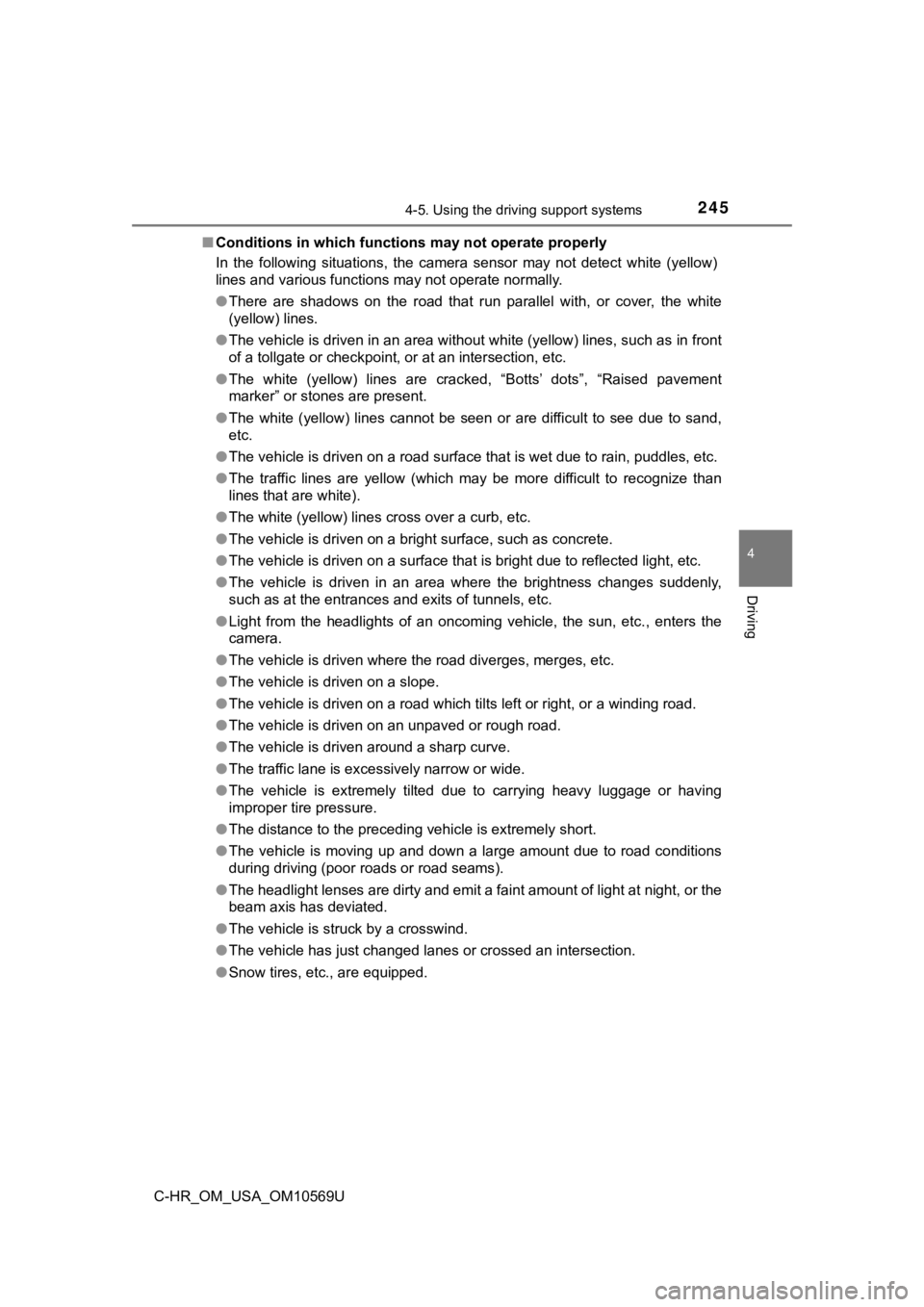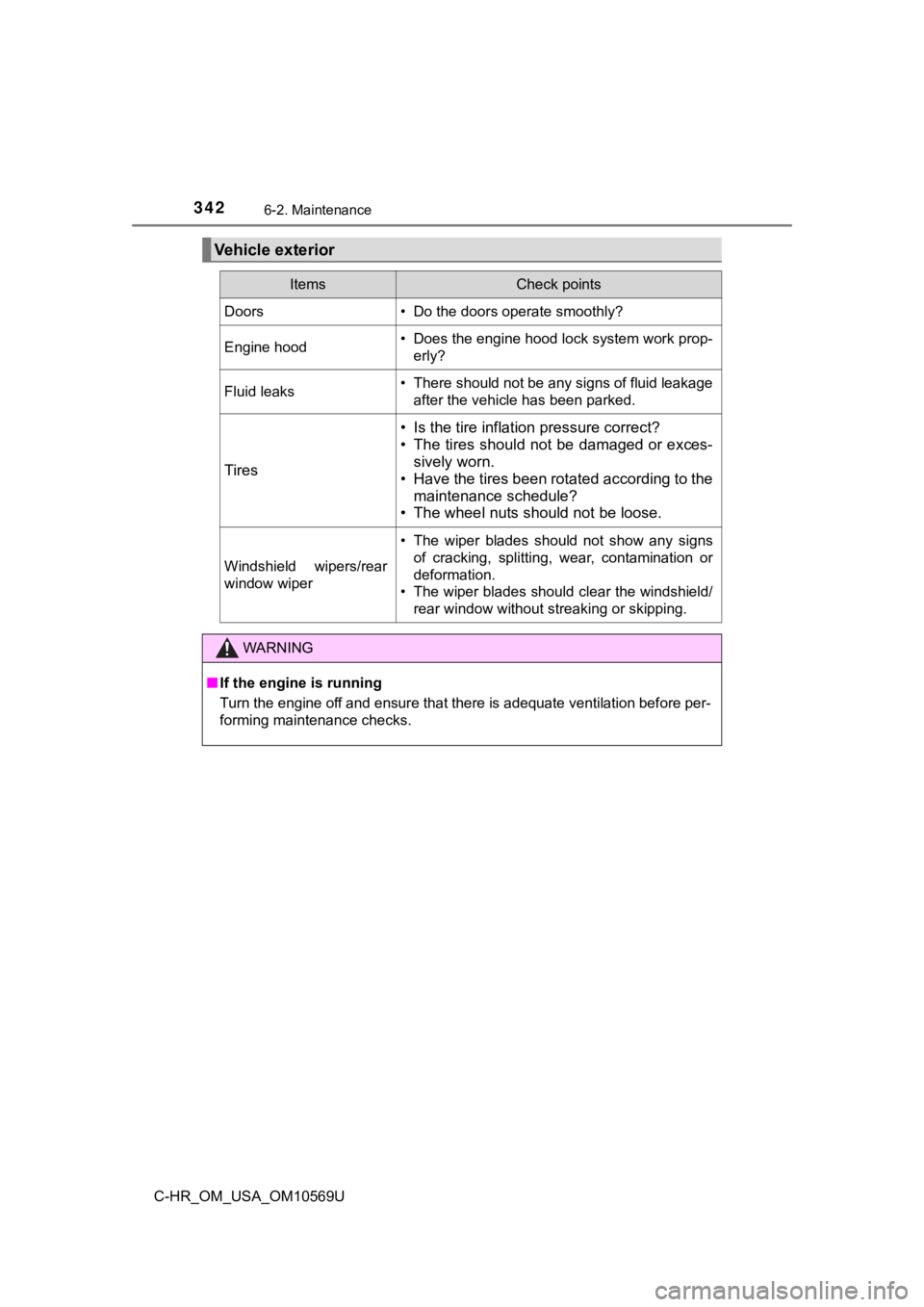tire pressure TOYOTA C-HR 2019 Owners Manual (in English)
[x] Cancel search | Manufacturer: TOYOTA, Model Year: 2019, Model line: C-HR, Model: TOYOTA C-HR 2019Pages: 532, PDF Size: 10.35 MB
Page 4 of 532

TABLE OF CONTENTS4
C-HR_OM_USA_OM10569U5-1. Using the air conditioning
system and defogger
Air conditioning system ..... 292
Seat heaters ...................... 300
5-2. Using the interior lights Interior lights list ................ 302• Interior lights ................. 303
• Personal lights .............. 304
5-3. Using the storage features
List of storage features...... 305 • Glove box...................... 306
• Console box .................. 306
• Bottle holders ................ 307
• Cup holders .................. 308
Luggage compartment features ........................... 309
5-4. Using the other interior features
Other interior features ....... 315 • Sun visors ..................... 315
• Vanity mirrors................ 315
• Clock ............................. 316
• Power outlet .................. 317
• Assist grips ................... 318
Safety Connect.................. 319 6-1. Maintenance and care
Cleaning and protecting the vehicle exterior .......... 328
Cleaning and protecting the vehicle interior ........... 333
6-2. Maintenance Maintenance requirements ................... 336
General maintenance ........ 339
Emission inspection and maintenance (I/M)
programs ......................... 343
6-3. Do-it-yourself maintenance Do-it-yourself service precautions ...................... 344
Hood .................................. 347
Positioning a floor jack....... 349
Engine compartment ......... 350
Tires................................... 365
Tire inflation pressure ........ 375
Wheels............................... 379
Air conditioning filter .......... 382
Wireless remote control/electronic key
battery ............................. 386
Checking and replacing fuses ................................ 390
Light bulbs ......................... 394
5Interior features6Maintenance and care
Page 13 of 532

13Pictorial index
C-HR_OM_USA_OM10569UWindshield wipers . . . . . . . . . . . . . . . . . . . . . . . . . . . . . . . . . P. 205
Precautions for winter . . . . . . . . . . . . . . . . . . . . . . . . . . . . . . . P. 286
To prevent freezing (windshield wiper de-icer)
*1. . . . . . . . . . . P. 295
Precautions for using a car wash . . . . . . . . . . . . . . . . . . . . . . . P. 330
Fuel filler door . . . . . . . . . . . . . . . . . . . . . . . . . . . . . . . . . . . . P. 213
Refueling method . . . . . . . . . . . . . . . . . . . . . . . . . . . . . . . . . . . P. 213
Fuel type/fuel tank capacity . . . . . . . . . . . . . . . . . . . . . . . . . . . P. 464
Tires . . . . . . . . . . . . . . . . . . . . . . . . . . . . . . . . . . . . . . . . . . . . P. 365
Tire size/inflation pressure . . . . . . . . . . . . . . . . . . . . . . . . . P. 468
Winter tires/tire chains . . . . . . . . . . . . . . . . . . . . . . . . . . . . P. 286
Checking/rotation/tire pressur e warning system . . . . . . . . .P. 365
Coping with flat tires . . . . . . . . . . . . . . . . . . . . . . . . . . . . . . P. 435
Hood . . . . . . . . . . . . . . . . . . . . . . . . . . . . . . . . . . . . . . . . . . . . P. 347
Opening . . . . . . . . . . . . . . . . . . . . . . . . . . . . . . . . . . . . . . . . . . P. 347
Engine oil . . . . . . . . . . . . . . . . . . . . . . . . . . . . . . . . . . . . . . . . . P. 464
Coping with overheating . . . . . . . . . . . . . . . . . . . . . . . . . . . . . P. 455
Camera
*2
Front side marker lights . . . . . . . . . . . . . . . . . . . . . . . . . . . . P. 195
Headlights . . . . . . . . . . . . . . . . . . . . . . . . . . . . . . . . . . . . . . . P. 195
Parking lights/daytime running lights . . . . . . . . . . . . . . . . . P. 195
Front turn signal lights . . . . . . . . . . . . . . . . . . . . . . . . . . . . . P. 186
Side turn signal lights . . . . . . . . . . . . . . . . . . . . . . . . . . . . . . P. 186
Tail lights/side marker lights/turn signal lights. . . . . . P. 186, 195
Back-up lights
Shifting the shift lever to R . . . . . . . . . . . . . . . . . . . . . . . . . . . . P. 181
License plate lights . . . . . . . . . . . . . . . . . . . . . . . . . . . . . . . . P. 195
Light bulbs of the exterior lights for driving
(Replacing method: P. 394, Watts: P. 469)
*1: If equipped
*2: Refer to “NAVIGATION AND MULT IMEDIA SYSTEM OWNER’S MANUAL”.
Page 82 of 532

822. Instrument cluster
C-HR_OM_USA_OM10569U
*1: These lights turn on when the engine switch is turned to the “ON” position
(vehicles without a smart key system) or IGNITION ON mode (vehi cles
with a smart key system) to indicate that a system check is bei ng per-
formed. They will turn off after the engine is started, or after a few seconds.
There may be a malfunction in a system if a light does not come on, or if
the lights do not turn off. Have the vehicle inspected by your Toyota dealer.
*2: The light comes on to indicate a malfunction.
*3: The light flashes to indicate a malfunction.
*3Parking brake indicator (U.S.A.)P. 422
*3Parking brake indicator (Canada)P. 422
Low fuel level warning lightP. 422
Driver’s and front passenger’s seat belt
reminder light P. 423
Rear passengers’ seat belt reminder lights (on
the center panel)
P. 423
*1Tire pressure warning light
P. 423
Warning lightsPages
Page 95 of 532

952. Instrument cluster
2
Instrument cluster
C-HR_OM_USA_OM10569U
● BSM (Blind Spot Mon itor) (if equipped) (P. 2 6 5 )
Select to set up the following items. • BSM function on/off
• RCTA function on/off
*
*
: The RCTA function can be enabled/disabled only when the BSM fu nc-
tion is enabled.
● Driving mode select ( P. 263)
● Vehicle Settings
(Tire pressure warning system) setup ( P. 367)
Select to initialize the tire pressure warning system.
● Meter settings
Select the menu to set up the following items.
• Language
Select to change the language on the display.
•Units
Select to change the unit of measure for fuel consumption.
• (Eco Driving Indicator Light) setup
Select to activate/deactivate the Eco Driving Indicator Light
• Drive information 1 and 2
Select to select up to 2 items that will be displayed on a Driv e informa-
tion screen, up to 2 Drive information screens can be set.
• Pop-up display
Select to set the pop-up displays*, which may appear in some situa-
tions, on/off.
• Speed limit
Select to setup speed limit indicated based on navigation syste m
(U.S.A. only)
• Default settings
Registered or changed meter settings will be deleted or returne d to their
default setting.
*: Route guidance display of the navigation system-linked system (if
equipped) and incoming call display of the hands-free phone sys tem.
Page 236 of 532

2364-5. Using the driving support systems
C-HR_OM_USA_OM10569U●
In some situations such as the following, sufficient braking fo rce may not be
obtained, preventing the system from performing properly:
• If the braking functions cannot operate to their full extent, such as when
the brake parts are extremely cold, extremely hot, or wet
• If the vehicle is not properly maintained (brakes or tires are excessively
worn, improper tire inflation pressure, etc.)
• When the vehicle is being driven on a gravel road or other sli ppery sur-
face
● Some pedestrians such as the following may not be detected by t he radar
sensor and camera sensor, preventing the system from operating properly:
• Pedestrians shorter than approximately 3.2 ft. (1 m) or taller t han approx-
imately 6.5 ft. (2 m)
• Pedestrians wearing oversized clothing (a rain coat, long skir t, etc.), mak-
ing their silhouette obscure
• Pedestrians who are carrying large baggage, holding an umbrella, etc., hiding part of their body
• Pedestrians who are bending forward or squatting
• Pedestrians who are pushing a stroller, wheelchair, bicycle or other vehi-
cle
• Groups of pedestrians which are close together
• Pedestrians who are wearing white and look extremely bright
• Pedestrians in the dark, such as at night or while in a tunnel
• Pedestrians whose clothing appears to be nearly the same color or
brightness as their surroundings
• Pedestrians near walls, fences, guardrails, or large objects
• Pedestrians who are on a metal object (manhole cover, steel plate, etc.)
on the road
• Pedestrians who are walking fast
• Pedestrians who are changing speed abruptly
• Pedestrians running out from behind a vehicle or a large objec t
• Pedestrians who are extremely close to the side of the vehicle (outside
rear view mirror, etc.)
Page 245 of 532

2454-5. Using the driving support systems
4
Driving
C-HR_OM_USA_OM10569U■
Conditions in which functions may not operate properly
In the following situations, the camera sensor may not detect w hite (yellow)
lines and various functions may not operate normally.
● There are shadows on the road that run parallel with, or cover, the white
(yellow) lines.
● The vehicle is driven in an area without white (yellow) lines, such as in front
of a tollgate or checkpoint, or at an intersection, etc.
● The white (yellow) lines are cracked, “Botts’ dots”, “Raised pa vement
marker” or stones are present.
● The white (yellow) lines cannot be seen or are difficult to see due to sand,
etc.
● The vehicle is driven on a road surface that is wet due to rain , puddles, etc.
● The traffic lines are yellow (which may be more difficult to re cognize than
lines that are white).
● The white (yellow) lines cross over a curb, etc.
● The vehicle is driven on a bright surface, such as concrete.
● The vehicle is driven on a surface that is bright due to reflec ted light, etc.
● The vehicle is driven in an area where the brightness changes s uddenly,
such as at the entrances and exits of tunnels, etc.
● Light from the headlights of an oncoming vehicle, the sun, etc. , enters the
camera.
● The vehicle is driven where the road diverges, merges, etc.
● The vehicle is driven on a slope.
● The vehicle is driven on a road which tilts left or right, or a winding road.
● The vehicle is driven on an unpaved or rough road.
● The vehicle is driven around a sharp curve.
● The traffic lane is excessively narrow or wide.
● The vehicle is extremely tilted due to carrying heavy luggage o r having
improper tire pressure.
● The distance to the preceding vehicle is extremely short.
● The vehicle is moving up and down a large amount due to road co nditions
during driving (poor roads or road seams).
● The headlight lenses are dirty and emit a faint amount of light at night, or the
beam axis has deviated.
● The vehicle is struck by a crosswind.
● The vehicle has just changed lanes or crossed an intersection.
● Snow tires, etc., are equipped.
Page 285 of 532

2854-5. Using the driving support systems
4
Driving
C-HR_OM_USA_OM10569U
WARNING
■When the TRAC/VSC is activated
The slip indicator light flashes. Always drive carefully. Reckless driving may
cause an accident. Exercise particular care when the indicator light flashes.
■ When the TRAC/VSC systems are turned off
Be especially careful and drive at a speed appropriate to the r oad condi-
tions. As these are the systems to help ensure vehicle stabilit y and driving
force, do not turn the TRAC/VSC systems off unless necessary.
■ Replacing tires
Make sure that all tires are of the specified size, brand, trea d pattern and
total load capacity. In addition, make sure that the tires are inflated to the
recommended tire inflation pressure level.
The ABS, TRAC and VSC systems will not function correctly if di fferent tires
are installed on the vehicle.
Contact your Toyota dealer for further information when replaci ng tires or
wheels.
■ Handling of tires and the suspension
Using tires with any kind of problem or modifying the suspensio n will affect
the driving assist systems, and may cause a system to malfuncti on.
Page 289 of 532

2894-6. Driving tips
4
Driving
C-HR_OM_USA_OM10569U
WARNING
■Driving with snow tires
Observe the following precautions to reduce the risk of acciden ts.
Failure to do so may result in a loss of vehicle control and ca use death or
serious injury.
● Use tires of the size specified.
● Maintain the recommended level of air pressure.
● Do not drive in excess of 75 mph (120 km/h), regardless of the type of
snow tires being used.
● Use snow tires on all, not just some wheels.
■ Driving with tire chains
Observe the following precautions to reduce the risk of acciden ts.
Failure to do so may result in the vehicle being unable to be d riven safely,
and may cause death or serious injury.
● Do not drive in excess of the speed limit specified for the tir e chains being
used, or 30 mph (50 km/h), whichever is lower.
● Avoid driving on bumpy road surfaces or over potholes.
● Avoid sudden acceleration, abrupt steering, sudden braking and shifting
operations that cause sudden engine braking.
● Slow down sufficiently before entering a curve to ensure that v ehicle con-
trol is maintained.
NOTICE
■ Repairing or replacing snow tires
Request repairs or replacement of snow tires from Toyota dealer s or legiti-
mate tire retailers.
This is because the removal and attachment of snow tires affect s the opera-
tion of the tire pressure warning valves and transmitters.
■ Fitting tire chains
The tire pressure warning valves and transmitters may not funct ion correctly
when tire chains are fitted
Page 327 of 532

327
6Maintenance and care
C-HR_OM_USA_OM10569U6-1. Maintenance and care
Cleaning and protecting the vehicle exterior .......... 328
Cleaning and protecting the vehicle interior ........... 333 6-2. Maintenance
Maintenance requirements ................... 336
General maintenance........ 339
Emission inspection and maintenance (I/M)
programs......................... 343
6-3. Do-it-yourself maintenance
Do-it-yourself service precautions ..................... 344
Hood ................................. 347
Positioning a floor jack ...... 349
Engine compartment ......... 350
Tires .................................. 365
Tire inflation pressure ....... 375
Wheels .............................. 379
Air conditioning filter.......... 382
Wireless remote control/electronic key
battery ............................. 386
Checking and replacing fuses ............................... 390
Light bulbs......................... 394
Page 342 of 532

3426-2. Maintenance
C-HR_OM_USA_OM10569U
Vehicle exterior
ItemsCheck points
Doors• Do the doors operate smoothly?
Engine hood• Does the engine hood lock system work prop-erly?
Fluid leaks• There should not be any signs of fluid leakageafter the vehicle has been parked.
Tires
• Is the tire inflati on pressure correct?
• The tires should not be damaged or exces- sively worn.
• Have the tires been rotated according to the
maintenance schedule?
• The wheel nuts should not be loose.
Windshield wipers/rear
window wiper
• The wiper blades should not show any signs
of cracking, splitting, wear, contamination or
deformation.
• The wiper blades should clear the windshield/
rear window without streaking or skipping.
WARNING
■If the engine is running
Turn the engine off and ensure that there is adequate ventilati on before per-
forming maintenance checks.